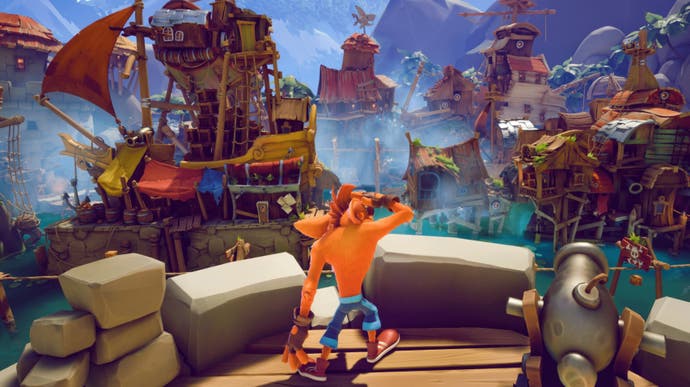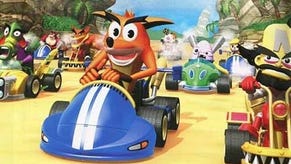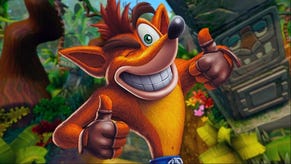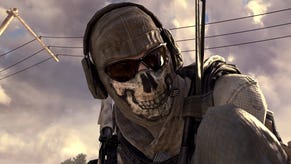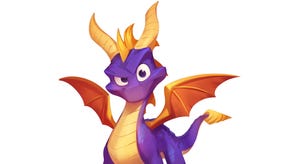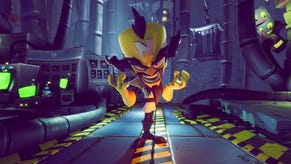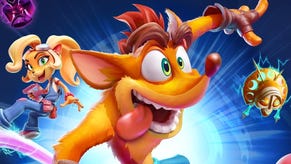Crash Bandicoot 4: It's About Time review - a flawed gem
Waow!
There are moments in Crash Bandicoot 4: It's About Time where you will come to a crossroads. Not the literal kind, of which there are actually many, the levels forking and pickling your brain on more than one occasion, but the spiritual. The kind that defines you, that reveals your exhausted, thousand-death weathered heart and shows you who you really are. Crash 4 is a game that forces you to look deep, deep down into your soul and ask yourself: just how bad do I want that one extra crate?
Crash 4 is hard, basically. Bastard hard. Toys For Bob, the former Skylanders studio that's since turned its hand to the recent Crash and Spyro trilogy remakes, and leads the way here, clearly sees that original trilogy's infamous difficulty as the template. Crash 4 is a direct sequel to Crash Bandicoot 3: Warped, Naughty Dog's last proper entry. All the Crash platformers since then - including another one directed by Mark Cerny! - seem to have been quietly redacted, as Activision goes big on the jortsy, VHS-fuzzed nostalgia of the mid-'90s PlayStation.

Whether or not you think outrageous difficulty, of the window-smashing, gripping-a-controller-until-its-plastic-audibly-creaks variety is what makes or breaks a Crash game will likely define your experience with Crash 4. Playing through it with artificial speed certainly exacerbates things, but there are moments where it moves from being challenging to simply awkward, the challenge derived from intentional clumsiness baked into one of the game's many new mechanics. At times the frustration can drown out everything the game offers, but it is only at times, and what it offers is really an awful lot.
There are two main ways to play Crash 4: 'modern' mode, and what Toys For Bob has called - rather cruelly, to anyone conscious of how distant the '90s now are - 'retro' mode. Retro is the Crash you'll remember: you collect Wumpa fruit to gain lives, and when you run out of lives you go back to the last save, Mario-style, while Gems, which now unlock skins, are earned in the traditional way. Modern mode is what the game recommends (and as such the one I played on for the most part), which is more carrot than retro mode's stick: Gems are still your overall objective, but are instead earned by collecting a certain percentage of a level's total Wumpa fruit, smashing all of its crates, completing a level with three deaths or less, and finding a hidden one somewhere along the way. There are no lives, so when you die you simply go back to the last checkpoint indefinitely.
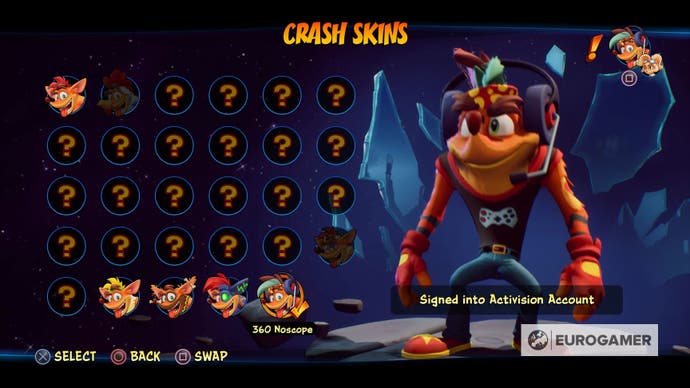
This is undoubtedly the biggest shift in how Crash 4 plays from the originals, because the originals' secret was less their difficulty so much as a product of it: their tension. Tension is baked into retro mode because each crate, each Wumpa, each hallowed life is potentially essential, each one a calculated risk. Risk death for a crate? Death, in exchange for another life? In modern mode, the tension is optional: you can reliably collect three or four of a level's five or six Gems by simply getting to the end of it and smashing most of the crates along the way, so whether the level feels tense or not depends on your own choice, of whether you want to get everything or whether you simply want to progress. Whether tension is really tension if you can choose not to have it is another question.
A problem, though, is that once you play modern mode you'll find it hard to go back - especially with everything Crash 4 throws at you, and how exactly it plays. The story here, which is all enjoyably goofy, kids TV fare, is that Neo Cortex and N.Tropy and all the usual, pun-laden bad guys have ripped open some rifts in space and time, and four special Quantum Masks, like your traditional Aku Aku one, are needed to close the rifts. Or something like that. The upshot is you get four new toys to play with as you go: Lani-loli, which phases things - crates, obstacles, enemies - in and out of existence with the press of a button; 'Akano, which lets you spin indefinitely, floating across huge gaps, blocking the previously unblockable and smashing previously unsmashable; Kapuna-wa, which lets you slow down time for a moment; and Ika-Ika, which lets you flip the direction of gravity.
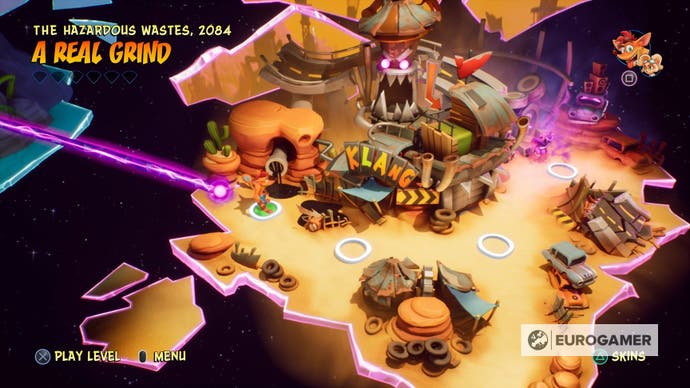
Most of these are excellent, tying in quite ingeniously to Crash and Coco's standard abilities (you can play as either, at any point, which I love) and their handful of new ones - a double-jump, which takes some getting used to, and BioShock Infinite-style rail-gliding, which is fun enough for brief moments but a little unresponsive to your inputs at times. Phasing high-value crates, and obstacles, and enemies, and deadly explosive Nitros in and out, for instance, while travelling at speed, dodging other enemies, platforming over huge gaps and juggling whatever else is thrown at you is utterly befuddling but a thrill, and an empowering one when you get it right. Some of the implementations are ingenious - some bonus rounds in particular stand out as proper master clockmaker stuff - and most of it plays into the enormously exacting nature of good Crash games, and the kind of on-the-fly hybrid of rapid fire puzzle-platforming that made them stand out.
Where Crash 4 struggles, though, is with some imprecision. Most levels only feature one Quantum Mask at a time, but I came to dread the 'Akano ones, which are all frustration and little reward, as painful to play with as its quantum mechanics are to think about. The infinite-spin sets Crash or Coco moving like a spinning top, never quite sitting still, and the result is a wafty, awkward, clumsy kind of platforming that often relies more on you brute-strengthing your way through sections by repeating them ad nauseum and hoping for a little luck, than really mastering a particular art.

There's also just a spot of general clumsiness to Crash and Coco's platforming, at times. Bandicoots seem to struggle with depth perception, occasionally but at least quite hilariously missing the easiest of ledges and jumps by just judging things as a smidge long or short, and makes me wish one of the Quantum Masks was just a pair of decent bifocals. It's not helped by the 3D-ification of the levels, which are all still linear but swap between side scrolling and the signature 'front scrolling' of original Crash on the fly - mostly fun, occasionally infuriating when you find yourself slightly out of line. The inclusion of a little yellow landing indicator, as opposed to Crash's original shadow, is useful but also something of an indictment of the clumsiness you're asked to fight.
These are real problems, but they are also secondary to what Crash 4 gets right. Most of its platforming is wonderful, throwing the kind of intricate, chaotic everything-at-once stuff you'd only find in the last ten levels of Crash 3 at you more or less from the start (again, not easy, and I preferred the gradient to Crash 3's ramping-up than the fairly instant incline here, but good fun).
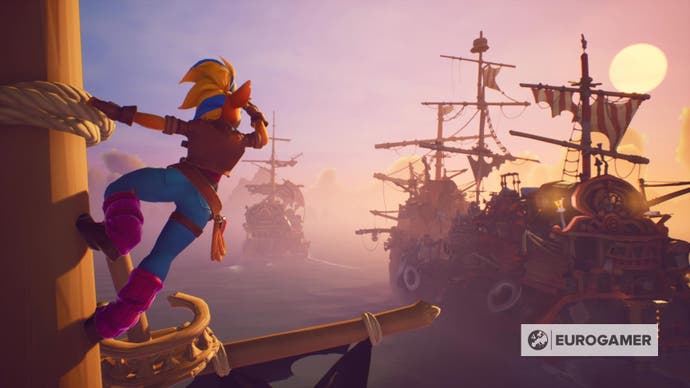
It's also enormously generous. There are countless secondary modes to try out that enhance the levels as they are, and which Toys For Bob didn't need to implement but nonetheless has, like a pass-the-pad mode that prompts you to hand the controller off to another player at every checkpoint or death, or a kind of 'battle' mode that lets two of you play a level at once, one as Crash the other as Coco, racing to the finish. This is on top of the traditional time trials, a huge array of extra, utterly devious bonus rounds unlocked by finding secret VHS tapes, and a new 'N-verted' mode for every level you beat which switches controls back to front, and which I frankly daren't even try.
There's also another, key part of Crash 4 which I haven't even mentioned, which is where it really sings. At various points you'll be re-introduced to some fan-favourite characters, which have their own, playable, parallel-timeline versions of levels you've already beaten, with entirely different systems involved. Neo Cortex is one, who has a smaller jump but a dash and a laser, which morphs enemies into different kinds of jumping platforms. Another is a return for Tawna, the once-redacted, tacky 'bonus round babe' from the originals, who arrives here in alternate-universe, genuinely badass action hero form, wielding an extremely satisfying grapple hook and roundhouse kick. There are more, which I won't spoil, but it's the trick of how they're introduced which I love, playing their own way for the first half of a level then joining at a fork in the road with the second half, where you switch back to Crash or Coco and play it again, only with everything slightly different.
It's a simple trick, but a wonderful bit of flair. Clearly Toys For Bob has a thing for getting the absolute most out of what you're given, and the effect is that you feel like it's a studio that really cares. Crash 4 is beautifully detailed, it features every gimmick and system and mechanic you can think of from the originals, and it's fun. Goofy, breezy, ebullient fun. There are little nods and cheeky easter eggs, a wealth of secrets, and apparently countless ways to play what is already, at least with three of its four new abilities, a very competent platformer.
Yes, the studio might've taken the originals' notorious difficulty a little too literally, but it's paid attention to the rest of those games too - and they've a cult following for a reason, beyond the especially thick pair of rose-tinted glasses with which games of that era are viewed. This is Crash 4: It's About Time's achievement, as a very, very long-awaited sequel. Brushing up against the better parts of the originals, but also getting surprisingly close to the idea you have of them in your head. A flawed gem, but no less brilliant.
